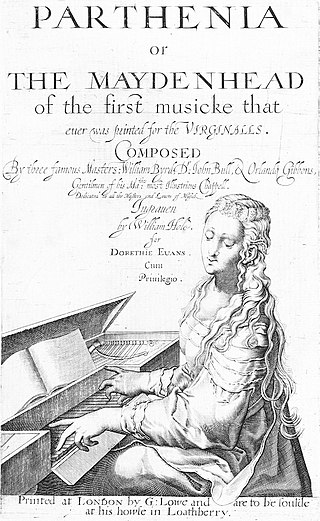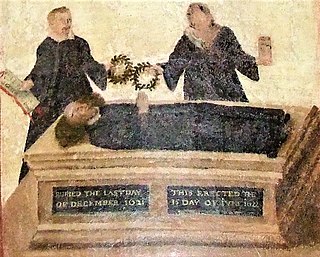
The Fitzwilliam Virginal Book is a primary source of keyboard music from the late Elizabethan and early Jacobean periods in England, i.e., the late Renaissance and very early Baroque. It takes its name from Viscount Fitzwilliam who bequeathed this manuscript collection to Cambridge University in 1816. It is now housed in the Fitzwilliam Museum at Cambridge. The word virginals does not necessarily denote any specific instrument and might refer to anything with a keyboard.

John Bull was an English composer, organist, virginalist and organ builder. He was a renowned keyboard performer of the virginalist school and most of his compositions were written for this medium.
Giles Farnaby was an English composer and virginalist whose music spans the transition from the Renaissance to the Baroque period.

Parthenia or the Maydenhead of the first musicke that ever was printed for the Virginalls was, as the title states, the first printed collection of music for keyboard in England. 'Virginals' was a generic word at the time that covered all plucked keyboard instruments – the harpsichord, muselaar and virginals, but most of the pieces are also suited for the clavichord and chamber organ. Though the date is uncertain, it was probably published around 1612. The 21 pieces included are ascribed to William Byrd, John Bull, and Orlando Gibbons, in three sections.
My Ladye Nevells Booke is a music manuscript containing keyboard pieces by the English composer William Byrd, and, together with the Fitzwilliam Virginal Book, one of the most important collections of Renaissance keyboard music.
Martin Peerson was an English composer, organist and virginalist. Despite Roman Catholic leanings at a time when it was illegal not to subscribe to Church of England beliefs and practices, he was highly esteemed for his musical abilities and held posts at St Paul's Cathedral and, it is believed, Westminster Abbey. His output included both sacred and secular music in forms such as consort music, keyboard pieces, madrigals and motets.
The Mulliner Book is a historically important musical commonplace book compiled probably between about 1545 and 1570, by Thomas Mulliner, about whom practically nothing is known, except that he figures in 1563 as modulator organorum (organist) of Corpus Christi College, Oxford. He is believed to have previously resided in London, where John Heywood inscribed the title page of the manuscript Sum liber thomas mullineri / iohanne heywoode teste.. A later annotation on the same page states that: T. Mulliner was Master of St Pauls school, but this has so far proved unsupportable. The provenance of the MS is unknown before it appears in the library of John Stafford Smith in 1776. After passing through the hands of Edward Francis Rimbault the MS was given to the British Museum in 1877 by William Hayman Cummings.
Priscilla Bunbury's Virginal Book is a musical commonplace book compiled in the late 1630s by two young women from an affluent Cheshire family. It is important more for its fingering indications than for the quality of the music it contains.
Elizabeth Rogers' Virginal Book is a musical commonplace book compiled in the mid-seventeenth century by a person or persons so far unidentified. Of all the so-called English "virginal books" this is the only one to mention the name of the instrument in the title, the others being so-called at a far later date.
The English Virginalist School usually refers to the English keyboard composers of the late Tudor and early Jacobean periods. The term virginalist does not appear to have been applied earlier than the 19th century. Although the virginals were among the most popular keyboard instruments of this period, there is no evidence that the composers wrote exclusively for this instrument, and their music is equally suited to the harpsichord, the clavichord or the chamber organ.
The Dublin Virginal Manuscript is an important anthology of keyboard music kept in the library of Trinity College Dublin, where it has been since the 17th century under the present shelf-list TCD Ms D.3.29.
Anne Cromwell's Virginal Book is a manuscript keyboard compilation dated 1638. Whilst the importance of the music it contains is not high, it reveals the sort of keyboard music that was being played in the home at this time.
Clement Matchett's Virginal Book is a musical manuscript from the late renaissance compiled by a young Norfolk man in 1612. Although a small anthology, it is notable not only for the quality of its music but also for the precise fingering indications that reveal the contemporary treatment of phrasing and articulation. Moreover, the manuscript is unusual in that each piece bears the exact date of its copying.

The Drexel Collection is a collection of over 6,000 volumes of books about music and musical scores owned by the Music Division of The New York Public Library. Donated by Joseph W. Drexel in 1888 to the Lenox Library, the collection, located today at the New York Public Library for the Performing Arts, is rich with materials on music theory and music history as well as other musical subjects. It contains many rare books and includes a number of significant 17th-century English music manuscripts.
"My Robin is to the greenwood gone" or "Bonny Sweet Robin" is an English popular tune from the Renaissance.

Drexel 4302, also known as the Sambrook Book, based on an inscription from a former owner, Francis Sambrook, is a music manuscript containing vocal and keyboard music from Italian and British composers, documenting the transition from Renaissance to Baroque music. Though literature on the manuscript has assumed the copyist was Francis Tregian the Younger, recent analysis has demolished that hypothesis.

Drexel 4180–4185 is a set of six manuscript partbooks copied in Gloucester, England, containing primarily vocal music dating from approximately 1615-1625. Considered one of the most important sources for seventeenth century English secular song, the repertoire included represents a mixture of sacred and secular music, attesting to the partbooks' use for entertainment and pleasure, rather than exclusively for liturgical use.

Drexel 5611 is a 17th-century music manuscript compilation of works written for virginal. Dating from either the end of the Commonwealth period or the early Restoration period, it is an important source for English keyboard music. It also includes a handful of works by French composers, reflecting the growing interest among English musicians in contemporary French keyboard music.

William Inglott or Inglot was an English organist and composer of the Elizabethan era, who is mostly associated with the cathedral in the English city of Norwich.

Drexel 3976, also known as The Rare Theatrical, is a 17th-century music manuscript compilation of works by the composer Matthew Locke, considered by some to be "the father of all Restoration dramatic music." The manuscript is a significant source of Locke's instrumental dramatic music with many works not known through any other source, although the contexts of the individual works and the names of the plays which they are from has not been documented.